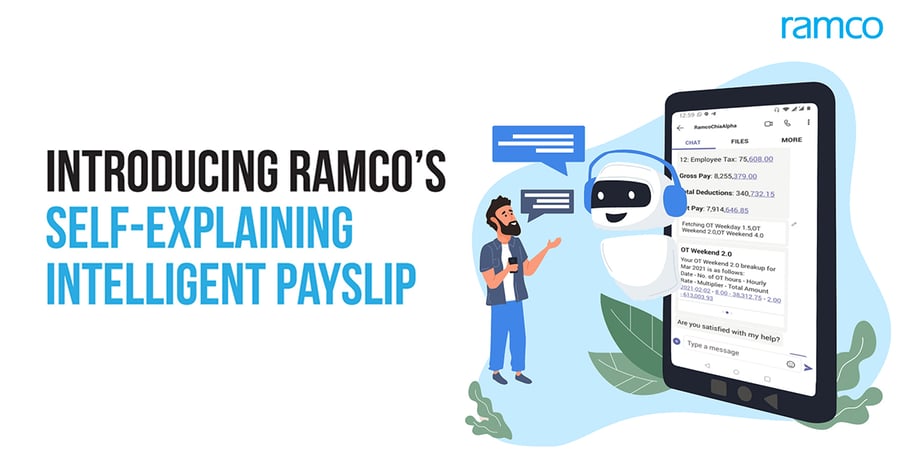
- Home
- Global Payroll
- Payroll Transparency & Employee Experience: An AI-cooked Recipe
Payroll Transparency & Employee Experience: An AI-cooked Recipe
Published :

A friend of mine who is also a payroll manager once told me that in his organization, of 30,000+ employees, the payroll helpdesk would experience a hectic 2-week after every pay run, with about 1000-1500 queries to answer. Two factors would further increase the volume:
The problem with payroll service queries is not that they are difficult to answer, but that they need to be personalized at scale.
Most of these queries fall into 5-6 categories, which may lead you to believe that it becomes easier to answer them. But the need to personalize the response to every employee makes this part of payroll process still laborious and daunting.
The payroll manager’s case clearly illustrates the volume and the process efficiency part of the payroll query management problem. You can also say that it is fairly easy to calculate the cost of running a payroll helpdesk. What is still missing in this equation is the Employee Experience (EX).
Lack of clarity about one’s salary and doubts about the computation of salary components can be a source of anxiety and dissatisfaction for employees.
HR and Payroll teams have the responsibility to provide a transparent employee payslip and educate the employees on how their salary is calculated. When this is poorly managed, problems creep in, with employees either assuming that their salary is not correctly computed or there has been a deliberate mistake, deteriorating employees’ experience
When payroll services are outsourced, this responsibility of educating employees about their salary invariably shifts to an outsourced helpdesk or a shared services center. However, this could be a double-edged sword for there is still a chance that this will further deteriorate Employee Experience because of:
As the most used mode of communication with helpdesks is an email or a ticketing system, further exacerbates the problem and brings down employees’ payroll experience.
The evolution of payroll services is essential for addressing the increasing demands of organizations and their employees. A modern payroll system not only simplifies the administrative tasks associated with payroll but also significantly enhances the overall employee experience. By implementing a comprehensive digital payroll solution, companies can ensure that employees have easy access to their payroll information, reducing confusion and dissatisfaction regarding salary computations.
Advanced features, such as self-explanatory payslips and AI-driven chatbots, empower employees to quickly obtain the answers they need without the frustration of long wait times or impersonal responses. This approach not only streamlines the payroll process but also allows payroll teams to focus on more strategic tasks, ultimately driving higher efficiency and employee engagement. By prioritizing a modern payroll system, organizations can transform their payroll services into a valuable asset that fosters trust and satisfaction among employees.
A modern, digital payroll system, on the other hand, can help overcome these experience barriers. For example, Ramco’s Self-Explaining Payslip is a smart, AI-based service that lets employees seek explanations of their compensation and payslip components through a chatbot.
According to Gartner, in 2019, companies spent an average of $2,420 per person on efforts to enhance employee experience. But then, when it comes to Employee Engagement and Employee Experience, compensation and payroll services are rarely talked about. It is time that we focus on the elements that make up a significant portion of employee experience and satisfaction at an organization.
Smart applications such as Ramco’s Self-Explaining Payslip can help organizations elevate their Employee Experience and at the same time free up their payroll teams from answering redundant questions in order to enhance employees’ payroll experience. To put it shortly, here is a better ROI proposition!
Enterprise asset management (EAM) involves the management of mission critical assets of an organization throughout each asset's lifecycle. EAM is used to plan, optimize, execute, and track the needed maintenance activities with the associated priorities, skills, materials, tools, and information. The aim is to optimize the quality and utilization of assets throughout their lifecycle, increase productive uptime and reduce operational costs.
Enterprise asset management (EAM) involves the management of the maintenance of physical assets of an organization throughout each asset's lifecycle. EAM is used to plan, optimize, execute, and track the needed maintenance activities with the associated priorities, skills, materials, tools, and information.
The software helps in effective maintenance of assets through preventive, predictive, shutdown and breakdown maintenance strategies. The system also helps enterprises mitigate equipment risks by enhanced safety standards. The streamlined operations and improved asset performance helps organizations increase their investment effectiveness.
EAM is important because it helps organizations track, assess, manage and optimize asset quality and reliability. Asset intensive Organizations have hundreds, thousands, even millions of assets which needs to be maintained to maximize / optimize life of these assets to increase the return on investment.
The key features of effective EAM are:
Asset Intensive companies under the following Industries :
Contact us for a meeting and schedule a demo
This differs on case to case basis, based on the type of installation and unique industry specific requirements. Contact us for a meeting and schedule a demo.
This differs on case to case basis, based on the type of installation and unique industry specific requirements. Contact us for a meeting and schedule a demo.
Stay Connected, follow us on LinkedIn / Twitter to know more about EAM Software latest trends.

All Rights Reserved. © Copyright 2024. Ramco Systems.